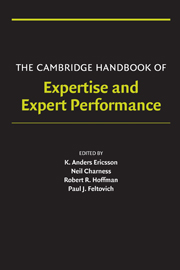Book contents
- Frontmatter
- Contents
- Acknowledgments
- Contributors
- PART I INTRODUCTION AND PERSPECTIVE
- PART II OVERVIEW OF APPROACHES TO THE STUDY OF EXPERTISE – BRIEF HISTORICAL ACCOUNTS OF THEORIES AND METHODS
- PART III METHODS FOR STUDYING THE STRUCTURE OF EXPERTISE
- 8 Observation of Work Practices in Natural Settings
- 9 Methods for Studying the Structure of Expertise: Psychometric Approaches
- 10 Laboratory Methods for Assessing Experts' and Novices' Knowledge
- 11 Task Analysis
- 12 Eliciting and Representing the Knowledge of Experts
- 13 Protocol Analysis and Expert Thought: Concurrent Verbalizations of Thinking during Experts' Performance on Representative Tasks
- 14 Simulation for Performance and Training
- PART IV METHODS FOR STUDYING THE ACQUISITION AND MAINTENANCE OF EXPERTISE
- PART V DOMAINS OF EXPERTISE
- PART VI GENERALIZABLE MECHANISMS MEDIATING EXPERTISE AND GENERAL ISSUES
- Author Index
- Subject Index
- References
11 - Task Analysis
from PART III - METHODS FOR STUDYING THE STRUCTURE OF EXPERTISE
- Frontmatter
- Contents
- Acknowledgments
- Contributors
- PART I INTRODUCTION AND PERSPECTIVE
- PART II OVERVIEW OF APPROACHES TO THE STUDY OF EXPERTISE – BRIEF HISTORICAL ACCOUNTS OF THEORIES AND METHODS
- PART III METHODS FOR STUDYING THE STRUCTURE OF EXPERTISE
- 8 Observation of Work Practices in Natural Settings
- 9 Methods for Studying the Structure of Expertise: Psychometric Approaches
- 10 Laboratory Methods for Assessing Experts' and Novices' Knowledge
- 11 Task Analysis
- 12 Eliciting and Representing the Knowledge of Experts
- 13 Protocol Analysis and Expert Thought: Concurrent Verbalizations of Thinking during Experts' Performance on Representative Tasks
- 14 Simulation for Performance and Training
- PART IV METHODS FOR STUDYING THE ACQUISITION AND MAINTENANCE OF EXPERTISE
- PART V DOMAINS OF EXPERTISE
- PART VI GENERALIZABLE MECHANISMS MEDIATING EXPERTISE AND GENERAL ISSUES
- Author Index
- Subject Index
- References
Summary
Introduction
Analyses of tasks may be undertaken for a wide variety of purposes, including the design of computer systems to support human work, the development of training, the allocation of tasks to humans or machines, or the development of tests to certify job competence. Task analysis is, therefore, primarily an applied activity within such diverse fields as human factors, human–computer interaction, instructional design, team design, and cognitive systems engineering. Among its many applications is the study of the work of expert domain practitioners.
“Task analysis” may be defined as what a person is required to do, in terms of actions and/or cognitive processes, to achieve a system goal (cf. Kirwan & Ainsworth, 1992, p. 1). A more recent definition, which at first sight has the merit of being short and crisp, is offered by Diaper (2004, p. 15): “Task analysis is the study of how work is achieved by tasks.” Both definitions are deceptively simple. They do, however, raise further issues, such as what a “system” is, or a “goal,” or “work,” or “task.” Complicating matters further, notions and assumptions have changed over time and have varied across nations. It is not my intention in this chapter to provide a complete historical overview of the various definitions that have been given for task analysis. The reader is referred to Diaper and Stanton (2004), Hollnagel (2003), Kirwan and Ainsworth (1992), Militello and Hoffman (2006), Nemeth (2004), Schraagen, Chipman, and Shalin (2000), and Shepherd (2001).
- Type
- Chapter
- Information
- The Cambridge Handbook of Expertise and Expert Performance , pp. 185 - 202Publisher: Cambridge University PressPrint publication year: 2006
References
- 16
- Cited by



